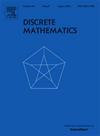Strictly critical snarks with girth or cyclic connectivity equal to 6
IF 0.7
3区 数学
Q2 MATHEMATICS
引用次数: 0
Abstract
A snark – connected cubic graph with chromatic index 4 – is critical if the graph resulting from the removal of any pair of distinct adjacent vertices is 3-edge-colourable; it is bicritical if the same is true for any pair of distinct vertices. A snark is strictly critical if it is critical but not bicritical. Very little is known about strictly critical snarks. Computational evidence suggests that strictly critical snarks constitute a tiny minority of all critical snarks. Strictly critical snarks of order n exist if and only if n is even and at least 32, and for each such order there is at least one strictly critical snark with cyclic connectivity 4. A sparse infinite family of cyclically 5-connected strictly critical snarks is also known, but those with cyclic connectivity greater than 5 have not been discovered so far. In this paper we fill the gap by constructing cyclically 6-connected strictly critical snarks of each even order . In addition, we construct cyclically 5-connected strictly critical snarks of girth 6 for every even with .
周长或循环连通性等于6的严格临界裂缝
如果移除任意一对不同的相邻顶点所得到的图是3边可着色的,那么色指数为4的snark -连通三次图是至关重要的;它是双临界的,如果相同的对任何不同的顶点成立。snark是严格的批评,如果它是批评,但不是双重批评。人们对严格的临界裂缝所知甚少。计算证据表明,严格的临界裂缝只占所有临界裂缝的一小部分。n阶严格临界snark存在当且仅当n为偶数且至少为32,并且对于每个这样的阶至少存在一个具有循环连通性4的严格临界snark。一个稀疏的无限族的循环5连通严格临界snks也是已知的,但那些循环连接大于5的到目前为止还没有发现。本文通过构造每个偶阶n≥342的循环6连通严格临界裂缝来填补这一空白。此外,对于n≡2的每个偶数n≥66,我们构造了周长为6的循环5连通严格临界snks (mod8)。
本文章由计算机程序翻译,如有差异,请以英文原文为准。
求助全文
约1分钟内获得全文
求助全文
来源期刊

Discrete Mathematics
数学-数学
CiteScore
1.50
自引率
12.50%
发文量
424
审稿时长
6 months
期刊介绍:
Discrete Mathematics provides a common forum for significant research in many areas of discrete mathematics and combinatorics. Among the fields covered by Discrete Mathematics are graph and hypergraph theory, enumeration, coding theory, block designs, the combinatorics of partially ordered sets, extremal set theory, matroid theory, algebraic combinatorics, discrete geometry, matrices, and discrete probability theory.
Items in the journal include research articles (Contributions or Notes, depending on length) and survey/expository articles (Perspectives). Efforts are made to process the submission of Notes (short articles) quickly. The Perspectives section features expository articles accessible to a broad audience that cast new light or present unifying points of view on well-known or insufficiently-known topics.
 求助内容:
求助内容: 应助结果提醒方式:
应助结果提醒方式:


